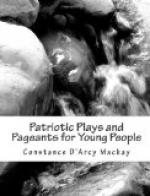SQUAWS. The squaws wear the same cotton khaki costumes as the Indian maidens, save that their blanket are of more somber colors, and their headgear is either omitted altogether, or consists of black, bronze, or dull green.
THE LITTLE INDIAN BOYS. They should drew in exact imitation of the older braves, save that they wear no war-paint.
PROPERTIES. For either an indoor or outdoor representation of this scene where it is impossible to have a real fire, have a pile of fagots and unionist them place large bunches of joss-sticks bound together with thread. These will burn easily and safely, and the blue smoke from them will simulate a waft from woodland embers.
The log can be made of two small vinegar barrels fastened together, covered with brown burlap, and then flecked with green and brown paint. The teepees should be of canvas, unbleached cotton, or burlap fastened over three slender, strong poles, stuck into the ground. They should be equal to bearing the weight of the canvas or burlap, and yet light enough to be removed and carried off the scene by the young Indian braves as they leave in the direction of the river when the scene ends.
DANCES. At the place indicated in the scene, the Indian maidens give one or more characteristic Indian dances. “The Blanket Dance,” one of the most widely known and picturesque of the Indian dances, follows somewhat the lines of a Virginia Reel. The Indian maidens stand in a line facing each other, their blankets wrapped about them. The head couple, facing each other, spread wide their blankets behind them like great butterfly wings. Then they dance forward and back, forward and back, beckoning, retreating, gesturing, and finally dance off, with one blanket wrapped about two pairs of shoulders. Then the next couple, and so on. All sorts of fantastic steps, gestures, bendings, and swayings can be introduced. A wide space should be left between the dancers, so that all they do can be clearly seen. Dancing in great circles, like a mild war-dance, yet without the whoops and wild gestures of the latter, is another form that lends itself to the out-of-doors. Another dance is the Eagle Dance; with arms spread wide, holding their blankets at wing-like angles, the dancers circle about each other, the dance growing wilder and wilder. Still another dance is the symbolical one of the Four Winds—North, South, East, West—done by four Indian maidens. The South Wind gentle and swaying; the West Wind fantastic, with arms upraised; the East Wind with streaming hair and rain-drops shining on finger tips; the North Wind wilder than them all, and finally driving them all before her.
MUSIC. Piano: MacDowell’s “An Indian Idyl,” “From an Indian Lodge.” These can be had orchestrated. For a band: “Tomahawk Dance,” by Andrew Herman. “Indian War Dance,” by Bellstedt. “The Sun Dance,” by Leo Friedman.




